 Overview
Overview
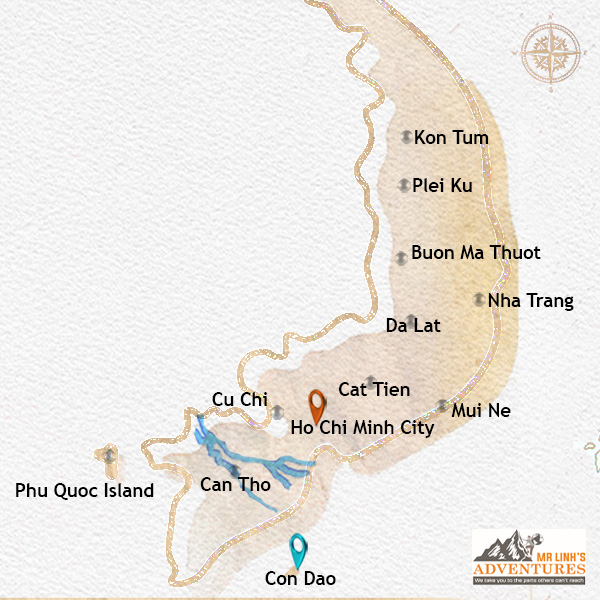
Off the southern coast of Vietnam lies
Con Dao, an archipelago of sixteen islands where unspoiled natural beauty meets a poignant history, offering a unique destination for adventure and reflection. With a small population of around 7,000 and a gentle flow of tourists, its deserted beaches and dense jungles create an alluring escape. Once a place of political exile, Con Dao has transformed into a serene haven, inviting travelers to rejuvenate amidst stunning seascapes and an authentic local culture.
Con Son's relatively recent painful history, coupled with its topography, has shaped its development, resulting in low-rise buildings that harmonize with the extensive national park.
This preserved environment fosters a rich ecosystem, home to remarkable species such as the black giant squirrel and the endangered dugong, a testament to the island's enduring natural heritage.
 Top Attractions
Top Attractions
Con Dao Awaits: From Sacred Past to Natural Splendor - Mr Linh's Adventures
Beyond its historical significance, Con Dao beckons with a wealth of experiences for every traveler, from underwater wonders to lush terrestrial trails and pristine shores.
Immerse yourself in an underwater paradise
Con Dao's crystal-clear waters teem with vibrant marine life, making it a haven for diving and snorkeling. Explore dazzling coral gardens, swim alongside graceful sea turtles, and marvel at the kaleidoscope of tropical fish.
Trek through emerald jungles and discover panoramic vistas
The expansive Con Dao National Park invites hikers to discover its lush tropical forests. Wander along scenic trails, encounter unique endemic flora and fauna, and be rewarded with breathtaking panoramic views of the surrounding archipelago.
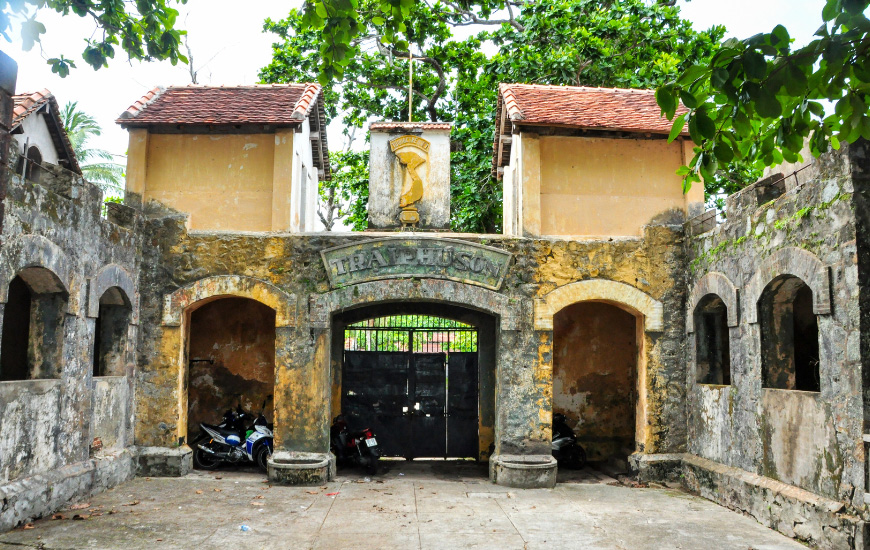 Echoes Behind Bars: The Story of Con Dao Prison - Mr Linh's Adventures
Echoes Behind Bars: The Story of Con Dao Prison - Mr Linh's AdventuresReflect on history within prison walls
Step back in time at the old Con Dao Prison, a powerful reminder of the islands' turbulent past. Explore the cells that once held Vietnamese political prisoners during pivotal periods of history.
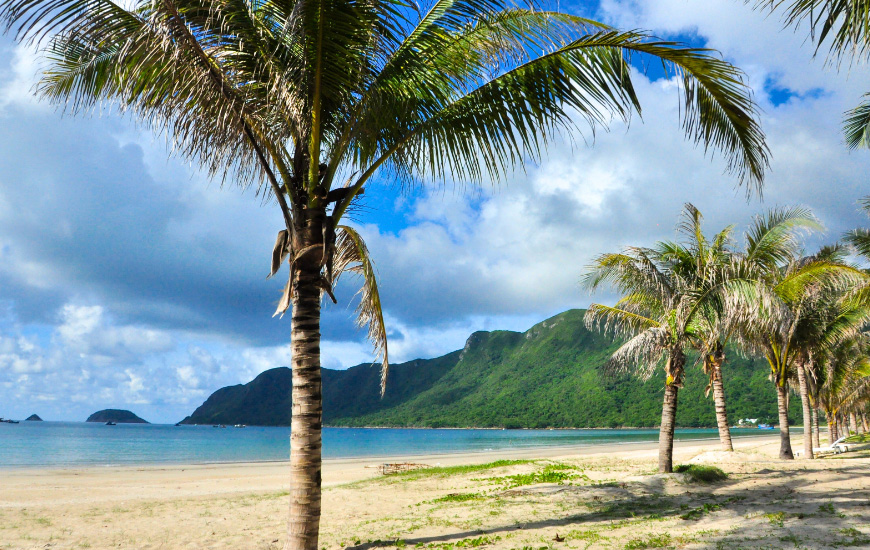 Silky Sands and Serene Waters: The Beachside Charm of Con Dao - Mr Linh's Adventures
Silky Sands and Serene Waters: The Beachside Charm of Con Dao - Mr Linh's AdventuresUnwind on pristine white sands and turquoise waters
Con Dao boasts magnificent white-sand beaches fringed by inviting turquoise waters, perfect for swimming, sunbathing, and pure relaxation. Discover the allure of popular spots like Dam Trau, An Hai, and Nhat Beach.
 See & Do
See & Do
 The Quiet Beauty of Con Dao Beach - Mr Linh's Adventures
The Quiet Beauty of Con Dao Beach - Mr Linh's AdventuresRelaxing on the beaches
The idyllic beaches and peaceful shores are the major attraction of Con Dao for many travelers. Although modest in size and sometimes accessible only at low tide, they are numerous and spread all over the island's perimeter.
Con Son, the main island, is home to some of the most beautiful beaches in Vietnam.
An Hai beach, popular for the beauty of its landscape and its easy access from the town of Con Son, is ideal for basking in the sun and contemplating the sea, with, from time to time, the passage of a fishing boat.
Dat Doc beach, in an arc around the coast, offers a crescent of silky sand and crystal-clear water suitable for swimming. It borders the private bungalows of the luxurious Six Senses complex, recently established on the island and having already welcomed celebrities such as Brad Pitt and Angelina Jolie. Despite the standing of the establishment, the beach remains accessible to the public thanks to accesses located on the main road.
Nhat beach, for its part, is revealed only at low tide, the rest of the time submerged under the waves. When the tide recedes, a crescent of white sand, dotted with a few rocks polished by the ocean, emerges to dry under the sun. The calm and the space it offers to visitors make this beach a privileged place to fully appreciate its wild beauty.
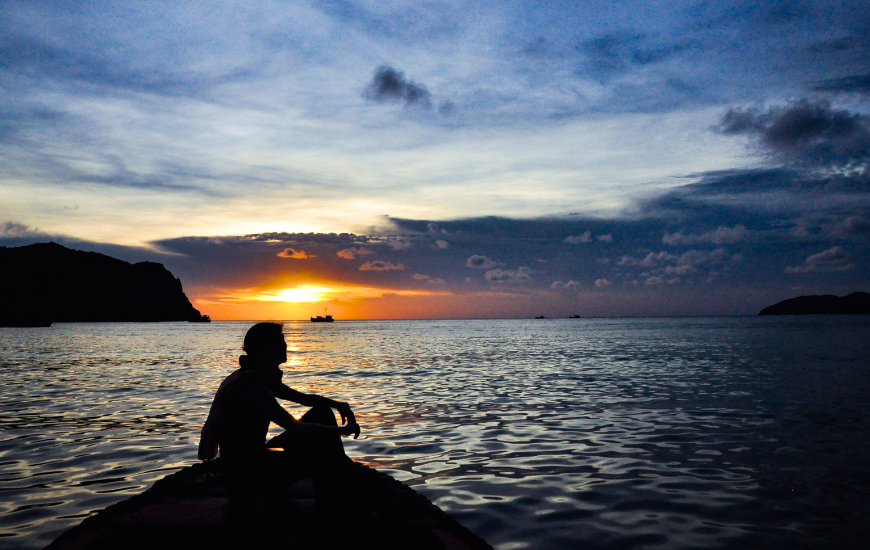 Sunset Bliss on Con Dao's Shore - Mr Linh's Adventures
Sunset Bliss on Con Dao's Shore - Mr Linh's AdventuresExploring the surrounding islands
Beyond the main island of Con Son, the surrounding islands offer beautiful opportunities for exploration.
The island of Bay Canh, located east of Con Son, is accessible by excursions (subject to authorization from the national park office). Once on this wild island, visitors can camp for the night, accompanied by forest rangers. If the season is right, they may have the chance to witness the spectacle of baby turtles being released into the sea.
Observing sea turtles
Con Dao is an important nesting site for sea turtles. Excursions are organized to observe the turtles coming to lay their eggs on the beaches at night.
Exploring the seabed
The waters of Con Dao offer as much wealth as the land, and are among the most beautiful in the country for diving. Several local companies offer excursions adapted to all levels. From March to August, the calm sea and optimal visibility make it the ideal season to explore the exceptional seabed of the archipelago. More than 200 species of fish, dugongs and sea turtles evolve in the corals and surrounding waters, offering an unforgettable spectacle.
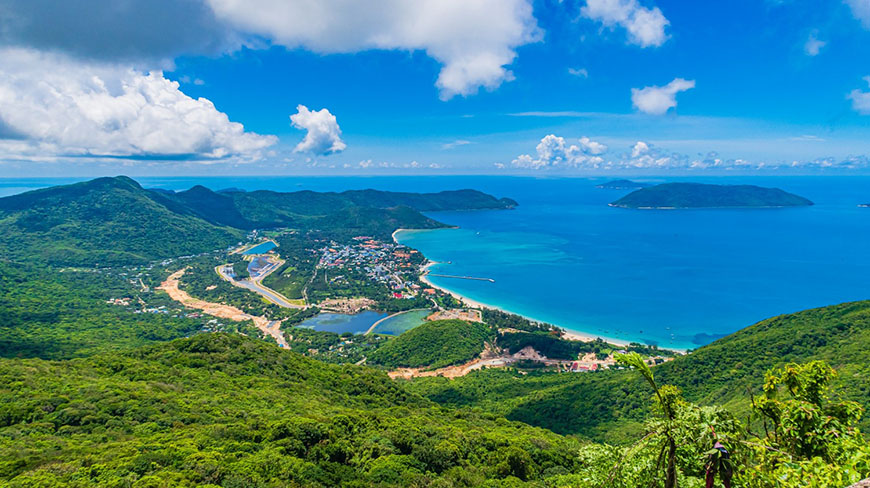 Enchanting landscapes of Con Dao National Park
Enchanting landscapes of Con Dao National ParkHiking to the end of the world
The interior of Con Son, with its national park, is an invitation to hiking in the heart of remarkable landscapes and wildlife. From mountain peaks to refreshing waterfalls, passing through peaceful corners of nature, the Con Son National Park offers a multitude of possibilities for hikers of all levels.
The primary forest of Con Dao is ideally revealed in the company of a local guide. He will guide you through enchanting landscapes, revealing secret waterfalls and preserved beaches. He will also help you observe the local fauna, including the black giant squirrel, the crab-eating macaque and the arched-finger gecko. The So Ray plantation, perched at an altitude of 260 meters, is also worth a visit. This former plantation, where prisoners worked for their French jailers, is today a privileged meeting place with monkeys, always on the lookout for some bananas.
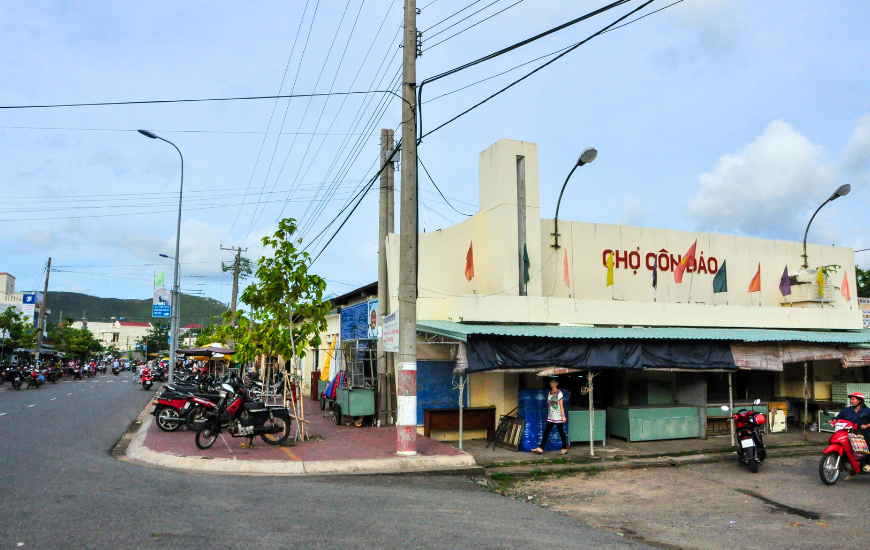 A Taste of Island Life at Con Dao Market - Mr Linh's Adventures
A Taste of Island Life at Con Dao Market - Mr Linh's AdventuresImmersion in local life
Con Dao cultivates a unique atmosphere, favored by its small population and the low tourist influx. A feeling of community and security reigns on the island, where the inhabitants seem more relaxed than their urban counterparts. The seaside promenade, forbidden to cars, invites strolling, encounters and contemplation. The daily market, a place of life and flavors, is a must to discover the local culture. Early in the morning, the modest building comes alive with a crowd of stalls offering fresh produce and hearty breakfasts. A dream opportunity to taste local specialties and observe the daily life of the inhabitants.
 Go Green
Go Green
Mr. Linh's Adventures offers tailor-made tours in Con Dao. Travelers will be able to explore the archipelago off the beaten track, accompanied by passionate local guides. The tours offered by Mr Linh's Adventure emphasize encounters with local communities, the discovery of the culture and history of Con Dao, as well as respect for the environment.
 Heritage
Heritage
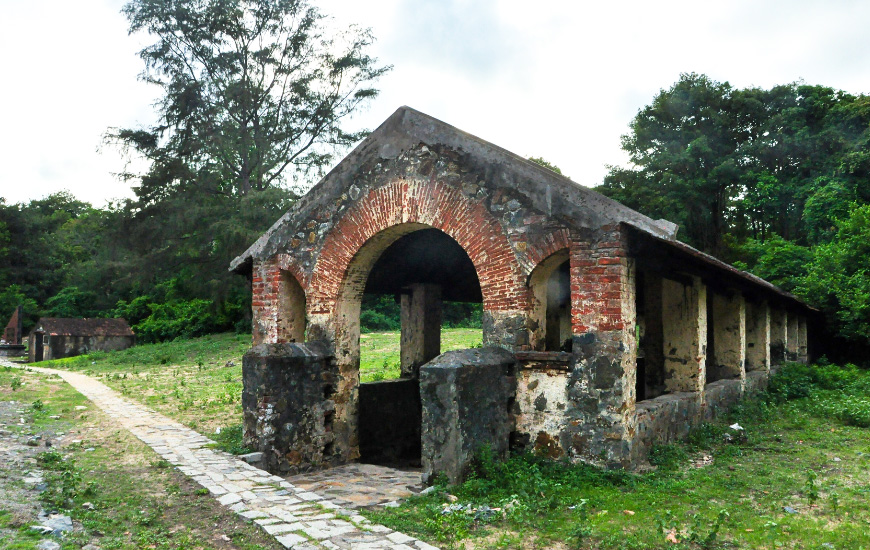 The Haunting Legacy of Con Dao Prison - Mr Linh's Adventures
The Haunting Legacy of Con Dao Prison - Mr Linh's Adventures
The exceptional state of the landscapes of Con Dao is partly due to its past as a prison. Nicknamed "Devil's Island", it housed until 1975 some of the most sinister prisons in the world. Thousands of prisoners, often for "crimes" against the power in place, were incarcerated in this penal colony. The oldest and largest prison, Phu Hai, with its tiny and overheated cells, saw many detainees die in sordid conditions. Today transformed into a museum, it presents skeletal mannequins that testify to the horror of the place.
The prison of Con Dao, often nickmaned "Hell on Earth" - Mr Linh's Adventures
The Phu Tuong camp, a place of memory and reflection, recalls the dark hours of the Con Dao prison. The "tiger cages", infamously known torture cells, testify to the brutality of the prison regime. Until the 1970s, prisoners were locked in these underground cages and subjected to degrading treatment: spraying with lime, beatings... It was not until the courage of Tom Harkin, who photographed these unbearable scenes, that the world became aware of these atrocities and that the tiger cages were closed.
Hang Duong, the cemetery of Con Dao - Mr Linh's Adventures
The Hang Duong cemetery houses the remains of many prisoners who died in the island's jails. If some graves are identified, many remain anonymous, testifying to the inhumanity of the prison system. Every night, a moving ceremony gathers families and loved ones, who come to gather on the graves and honor the memory of the deceased. Among them, Vo Thi Sau, a young resistance fighter executed at the age of 19, became a symbol of courage and patriotism. Captured at 17, she was sent to Con Dao and executed for her actions within a resistance group. Her refusal to wear a blindfold during her execution and her song, a symbol of her faith in freedom, made her a national martyr.
Van Son Pagoda, or Nui Mot Pagoda, offers a serene retreat amidst Con Dao's mountains. Though established in 1964 with a dual purpose – serving spiritual needs and masking a political agenda – its tranquil beauty now provides solace and reflection.
The folklore of Con Dao is rich in poignant stories, like the tragic story of Phi Yen. This heroine, torn between her maternal love and her loyalty to her husband, is a strong symbol of the local culture. Her sanctuary invites you to discover this legend. Phi Yen, nicknamed "the flying swallow", was the wife of Lord Nguyen Anh, whose collaboration with the French is controversial. During their exile in Con Dao, Nguyen Anh is said to have promised their son to the French in exchange for their support. Phi Yen opposed it, and Nguyen Anh, furious, ordered to drown their child. Despite this tragedy, Phi Yen remained faithful to her husband and committed suicide to avoid the advances of another man. The story of Phi Yen and Nguyen Anh, although romanticized, is deeply rooted in the island's culture. The inhabitants go to the sanctuary of Phi Yen to pray for the values she embodies: maternal love and fidelity. The temple of Prince Cai, located on the island, houses a sanctuary dedicated to their son and his tomb. The statue of a white horse evokes lost youth and innocence.
 Food & Drinks
Food & Drinks
Do not miss out the Oyster Porridge!
After a day of exploring Con Dao, the night market on Tran Huy Lieu Street is the perfect place to enjoy a tasty local dish and recharge your batteries.
On the menu: fresh seafood of the day and Vietnamese specialties. The choice varies according to the catch, but the freshness of the products and the tasty typical sauces are always there.
Con Dao's Vu Nang snail, a culinary rarity, graces the island's tables year-round, yet appears exclusively on full moon nights. Whether boiled, baked, or in salads, its delicate flavor, especially when paired with local wine, makes it an unmissable Con Dao delicacy.
Another popular and easiest seafood dishes to find is oyster porridge, (Chao Hau), thick and tasty. The sellers, experts in the field, serve steaming bowls of porridge from their stalls.
Shellfish are also very popular on the island. Red lobsters and Con Dao crabs are regularly on the menu.
 Directions
Directions
Location
Con Dao is located about 230 km from Vung Tau and 1,800 km from Hanoi.
How to get there
You can reach Con Dao by plane from Hanoi or Ho Chi Minh City. Vietnam Airlines offers regular flights to Con Dao Airport. It is also possible to reach Con Dao by ferry from Vung Tau, but the journey is longer and can be uncomfortable in case of rough seas.
Ticket prices: Air ticket prices vary depending on the season and the airline. It is advisable to book in advance to benefit from advantageous rates.
Best season
The best season to visit Con Dao is from March to September, during the dry season. The temperatures are pleasant and the sun is there.
Con Dao, with its captivating blend of natural beauty, historical depth, and authentic local culture, offers a multifaceted destination for the discerning traveler. From its poignant historical sites to its vibrant underwater ecosystems and tranquil beaches, Con Dao invites visitors to explore, reflect, and connect with a unique corner of Vietnam.